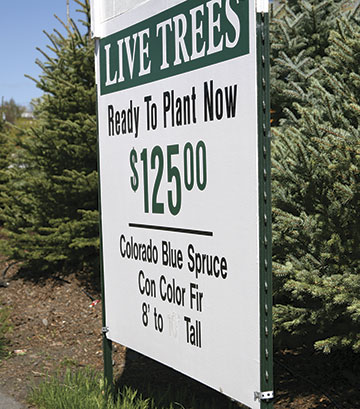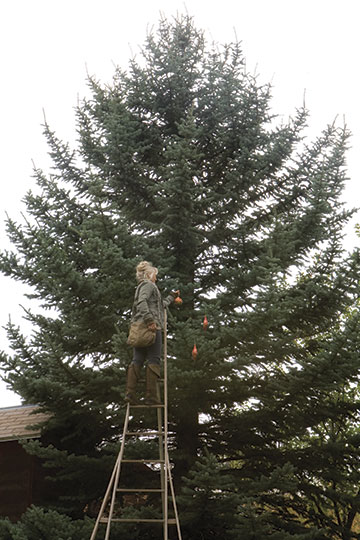How about a Christmas tree that’s roughly four feet tall, perfectly symmetrical, and very much alive? In late September, my local nursery puts their trees on clearance, so that’s when I usually adopt my soon-to-be Christmas tree for around $60. Some years there’s another local endeavor selling live trees for $125 but not this year.
My feelings are identical to the way I felt when my parents let me pick out a puppy or choose from a litter of kittens. This one! Its roots are securely tucked into a root ball covered in burlap. Each year, I bring a tree home and carefully and routinely water it until I can get it planted, usually in March sometime.

Grown and out the door, my farm is home to a couple dozen trees I’ve fallen for over the years. Some of them are now HUGE! Thought to protect homes from evil, it’s no surprise we want them indoors with us. Outside greenery, brought inside, is the centerpiece of our holiday season.
The worship of trees goes back to the time of the earliest Pantheists. (Pantheism is the worship of nature.) Integrated into our holiday customs are early Christian and Jewish practices, Roman traditions, medieval pagan rituals, and Victorian nostalgia. Germans introduced Americans to the Christmas tree (tannenbaum), but they weren’t the first to believe that evergreen trees represented eternal life because of their perennial green color during winter. Ancient homes were decorated with boughs and the tops of trees turned upside down to entice the spirit of nature inside for prosperity and good health.
Cut, faux, or alive—what’s your centerpiece this year? Having tried them all, I can make a convincing argument for all three. For every Christmas tree cut, two are planted. With over a million acres set aside to grow Christmas trees, one acre provides the daily oxygen requirement for some 18 people, but there’s just something sad to me about that lifeless hulk slowly turning brown out the back door. And I can’t for the life of me envision Pan, the god of woods, fields, and flocks, coming into my home to play his flute for my faux tree, even if it is an “eternal” tree.
Check out www.livingchristmastrees.org, a Portland, Oregon-based company that’s been in business for over 20 years delivering full-size Christmas trees and then planting them at schools, churches, and parks after Christmas.






















































Wow, what a magnificent beauty you are hanging ornaments on! Here in Florida, indigenous Southern Red Cedars are popular Christmas trees. When we lived in our first home which had a large back yard facing fields for agriculture crops, we bought live trees and then planted them around the property. 34 years later, they are huge and still forming part of the landscape. I love to see them every time I pass by the old place. Here in town, there is neither enough sun or space to buy live trees so we have opted for Frazier firs grown on farms in North Carolina. I love the smell of evergreen in my home this time of year!
I love going for a drive to the mountains and choosing the perfect tree with a thermos of cocoa in tow. But, this year we just have a faux tree. I do want to take the atv with my honey into the cedar and juniper grove and glean some branches with juniper berries to tuck in the bare spots on the tree and to decorate the rest of our home with. I just love fresh evergeens 🙂
There are two ancient 3 story high hollies in a small town nearby and every year I have permission to cut as many berry filled branches as I wish. They are beyond beautiful and I put big bunches in buckets ,delivering more branches to all my friends. Despite several acres of woods at my farmette, not a single one is a “Christmas Tree” type. And only 2 very small hollies are growing here.
The local Pennsylvania “Dutch” here in Lancaster country, often use the cedars that border fields as their Christmas trees, since these are considered ” junk” trees. The thrifty ” Dutch” also save the dried out dead Christmas tree after the holidays and recycle it by covering the bare branches in cotton and mica ” snow” to use the following years. It is also a ” Dutch ” custom to hang a live tree upside down usually on the porch, for good luck and always to have a bird’s nest in it. They also decorate their trees with large pretzels as they represent praying hands.
I have 2 indoor cats, Duke and Earl, who love to eat pine needles, ( which sadly make them sick ) ,so I can’t have a real tree indoors.
Your tree looks like some of the “wild” ones hubby & I planted 20 years ago. We collected most of them from the side of our road before the power company came to clear them away. They start out at 2′-3′ but are now almost 40′. We built a windrow to help keep the soil on the open acreage & the blustery southern winds off Lake Michigan a little calmer. As I walk on our property, I love to see these trees blowin’ in the wind. I wish that hubby & I didn’t have tree allergies so I could once again bring greenery indoors. Alas, we just enjoy it through our windows & on our walks. And no more getting stuffy noses, running eyes & coughs!